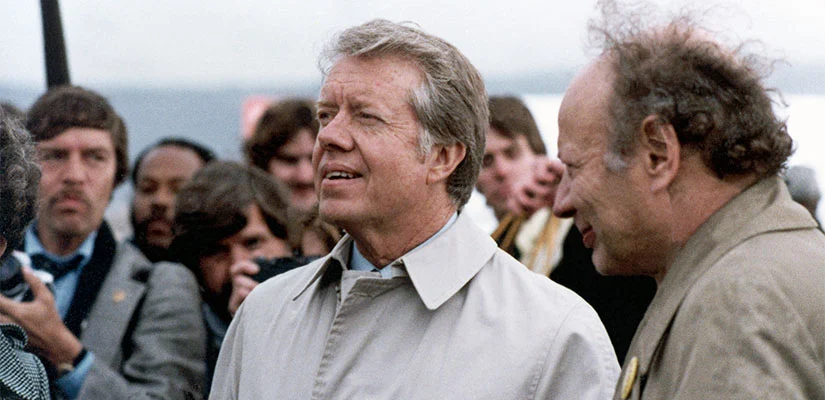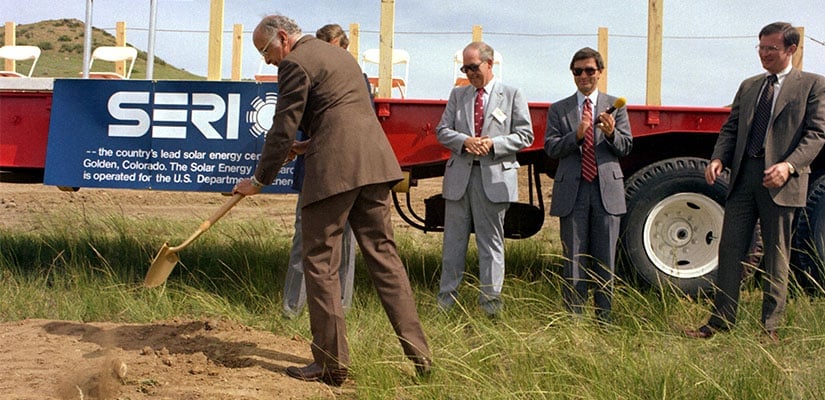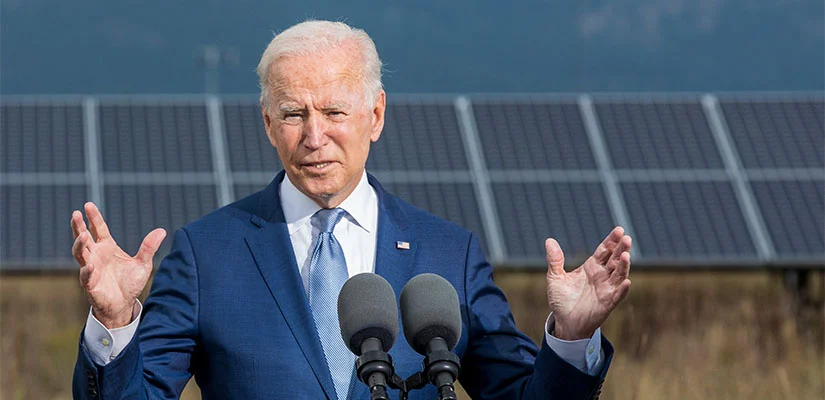Laboratory History
NREL's rich history of renewable energy and energy efficiency research and innovation spans decades.

Perfect Weather for a Streamlined World by Robert McCall, 1979
Want to dig deeper into NREL's history? Download National Renewable Energy Laboratory History: 1977–2016.
Learn more about the people behind the laboratory's research developments by downloading Clean Energy Innovators: NREL People Working to Change the World. (Or purchase a hard copy of Clean Energy Innovators for the at-cost price when you use coupon code "NREL" at checkout.)
Addressing the Energy Crisis Through Innovation

President Jimmy Carter visits SERI alongside SERI Director Paul Rappaport (right). Photo by NREL staff
1973
As tensions flare over aid to Israel, the Organization of Petroleum Exporting Countries raises the price of oil to more than $5 per barrel. Later, Saudi Arabia cuts off all oil exports to the U.S., sparking an energy crisis.
1974
In October, President Gerald Ford establishes the Energy Research and Development Administration (ERDA) and signs the Solar Energy Research, Development, and Demonstration Act, which creates the Solar Energy Research Institute (SERI).
The establishment of SERI marks the first time the U.S. tackles energy issues through a center of innovation to create and market renewable energy technologies, versus through policy.
1976
In March, ERDA issues a request for proposal from organizations interested in establishing and operating SERI. Among the competition is the Midwest Research Institute (MRI) in Kansas City, Missouri.
MRI partners with Colorado Governor Richard Lamm and the state legislature to issue its ERDA proposal, which includes a 300-acre site on top of South Table Mountain in Golden as the future home of SERI.
ERDA selects the Rocky Flats Plant test site northwest of Denver as the prime location for the federal wind program's research and development efforts.
1977
In February, President Jimmy Carter tells the nation how critical SERI's work will be to his administration's goals: "We will emphasize research on solar energy and other renewable energy sources."
In March, ERDA selects MRI to operate SERI in Golden, Colorado.
On July 5, SERI, the first federal facility dedicated to developing solar power, opens with Princeton-based photovoltaic researcher Paul Rappaport as director. A small staff moves into temporary facilities in the Denver West Office Park near South Table Mountain.
In August, President Carter forms the U.S. Department of Energy, replacing ERDA.
SERI begins taking on part of the federal wind program's research and development work.
1978
On May 3, President Carter visits South Table Mountain to celebrate Sun Day, a new holiday commemorating the dawn of a new solar age. In addition to addressing the gathered crowd, President Carter reviews some of SERI's work, including solar photovoltaic systems, wind turbines, a biomass converter, and a model of a solar power plant.
In November, President Carter signs the Solar Photovoltaic Energy Research, Development, and Demonstration Act of 1978. The act tasks SERI researchers with reducing the average cost of solar photovoltaic systems, or solar cells, to $1 per watt by 1988. (For context, a 1-watt cell cost almost $300 per watt in 1956 and $77 per watt about 25 years later.)
1979
SERI Director Paul Rappaport resigns following a cancer diagnosis. Denis Hayes—the national coordinator for the inaugural Earth Day—takes over to advance SERI's mission of transitioning from oil to renewables.
Perseverance Despite Funding Cuts and Uncertainty

SERI Director Harold Hubbard shovels dirt at the groundbreaking for the Field Test Laboratory Building. Photo by Warren Gretz, NREL
1980
SERI's budget increases from $90 million to $130 million—estimated to be more than all other nations' combined spend on renewable research. The staff grows to nearly 1,000.
SERI launches the Denver Metro Home Builders Program to bring new building technology into common commercial practice. A "Parade of Homes" draws more than 100,000 visitors touring model houses constructed using energy-efficient practices in the first weekend alone. The 2-week event yields 31 sales contracts and more than 60 preorders for additional passive solar homes.
1981
President Ronald Reagan slashes the SERI budget to less than $30 million and reduces its staff to 450 people; Director Denis Hayes resigns.
SERI relies on spending earmarks from congressional supporters to fund its work.
MRI Senior Vice President Harold "Hub" Hubbard is named SERI's new director.
In July, SERI earns its first patent for a concept that boosts the conversion efficiency of solar cells.
1982
In January, SERI Director Hubbard outlines plans for SERI's future growth—including a $9.5 million federal grant for a laboratory building and field test site on its South Table Mountain campus.
SERI wins its first R&D 100 Award for researcher Tom Reed's Oxygen High Pressure Gasifier, which uses heat, oxygen, and pressure to turn wood and waste into a gas for generating electricity and heat. (In 1987, industry partner Syn-Gas Inc. commercializes the prototype and produces 75 tons of syngas per day.)
1983
SERI commits to expand its scope to include wind, biomass/alcohol fuels, solar thermal, hydrogen, ocean energy, and buildings conservation, in addition to photovoltaics.
SERI opens its first building on the South Table Mountain campus—the Field Test Laboratory Building—which features high-bay laboratories for biotech research and assembly areas for outdoor experiments; skylights and a glass front for passive solar heat; and an early iteration of smart building technology that keeps an eye on the structure's energy use and provides warnings if any systems need a tune-up.
SERI creates a crystalline silicon solar cell with a record conversion efficiency rate of 18%.
1984
On Oct. 1, DOE merges the SERI and Rocky Flats programs to create the Wind Energy Program at SERI.
SERI scientists develop the first practical multijunction cell, which is the basis for record-setting solar efficiency numbers in the coming decades and the foundation of all modern solar cells used to power satellites.
1986
In October, President Reagan signs the Federal Technology Transfer Act of 1986, allowing federal labs to enter into a consortium and negotiate licensing agreements for their patented technologies. The act makes it easier for SERI researchers and scientists to bring technologies they develop into the market.
1989
SERI Director Hubbard retires, and Gene Mannella—former director of Washington operations for the Electric Power Research Institute—is named its new director.
SERI's Structural Testing Facility for wind systems opens.
SERI wins the Federal Laboratory Consortium's Excellence in Technology Transfer Award for its work with amorphous silicon photovoltaics, the same technology first introduced in solar-powered calculators.
By the end of the decade, 20 startup companies emerge from SERI R&D.
Achieving National Lab Status

President George H. W. Bush announces the designation of SERI as DOE's National Renewable Energy Laboratory. Photo from the Presidential Materials Project
1990
Director Gene Mannella leaves SERI, and Duane Sunderman, former head of MRI's Kansas City operations, replaces him.
1991
On Sept. 16, President George H.W. Bush elevates SERI to national laboratory status and renames it the National Renewable Energy Laboratory (NREL) to more accurately reflects its range of work.
NREL wins its first wind-related R&D 100 Award for advanced wind turbine blades. The designs produce up to 30% more electricity than previous iterations and become the industry standard.
1993
The Solar Energy Research Facility opens at NREL, providing 53,000 ft2 of lab and office space. It's the first campus building project for which NREL's scientists formally and actively participate in the design process.
1994
DOE dedicates the National Wind Technology Center, to be run by NREL at the Rocky Flats site.
Director Duane Sunderman retires, and NREL names its new director, Charlie Gay, former president of ARCO Solar, a solar photovoltaics company.
NREL opens its Alternative Fuels User Facility, which provides labs for methanol and ethanol production as well as space for industry partners to evaluate alternative biofuels.
NREL opens its Education Center, a 6,400-ft2 facility to provide the public training and learning opportunities around the lab's work.
1995
Congress cuts NREL's budget for Fiscal Year 1996 by 30% and eliminates more than 225 positions, forcing the lab to abandon or sharply curtail several programs.
1996
Director Charlie Gay leaves, and NREL names a new director, Richard Truly, former vice admiral in the U.S. Navy and the eighth administrator of NASA.
NREL completes the Thermal Test Facility and the Outdoor Test Facility, used by industry to foster uniform standards of testing and measurement, evaluate prototypes, and develop market-ready solar modules.
1999
The 2,600-ft2 Solar Radiation Research Laboratory opens, housing five labs that support optical, electronic, and meteorology functions.
Renewed Executive Support

President George W. Bush leads an energy panel discussion at NREL as part of the Advanced Energy Initiative. Photo by Jack Dempsey, NREL
2000
In October, DOE launches a consortium of its laboratories led by NREL called the National Bioenergy Center to make cellulosic ethanol cost-competitive with gasoline by 2012 (a goal NREL later achieved).
2003
NREL and partner First Solar win an R&D 100 Award for a technology that enables mass production of thin-film solar modules, likely to produce the lowest-price-per watt photovoltaic modules in the world.
2005
Dan Arvizu, a veteran renewable energy scientist and entrepreneur, becomes NREL's director following Director Richard Truly's retirement.
2006
Congress cuts $28 million from NREL's budget, forcing NREL to lay off 32 employees.
President George W. Bush reverses NREL layoffs made weeks earlier and visits campus to discuss the "mixed signals" about funding at the lab and his commitment to its work. He leads a panel discussion on his Advanced Energy Initiative, which includes a 22% increase in clean energy research at DOE.
NREL completes construction on the Science and Technology Facility, which is designated the first Leadership in Energy and Environmental Design (LEED) platinum-certified federal facility, 40% more efficient than comparable labs.
The Process Development and Integration Laboratory opens, bringing together researchers, tools, data, and materials across multiple disciplines.
Campus Expansion Fuels Productivity

The Energy Systems Integration Facility (foreground) with the A wing of the Research Support Facility (left) and the Solar Energy Research Facility (background) on NREL's South Table Mountain campus in Golden. Photo by Joshua Bauer, NREL
2010
NREL opens the first two wings of its Research Support Facility (the third opens in 2013). The facility wins 40 awards for its architecture, construction, engineering, sustainability, and technology transfer.
2012
NREL achieves the goal set forth by the National Bioenergy Center in 2000 by creating affordable cellulosic ethanol using two separate conversion platforms: biochemical and thermochemical.
NREL completes construction on several facilities on its South Table Mountain campus, including:
- The LEED Gold-certified Integrated Biorefinery Research Facility
- The Vehicle Testing and Integration Facility
- The NREL Café, a LEED Platinum-rated facility that serves as a model for cafeterias at corporate campuses, hospitals, and restaurants nationwide
- The NREL Parking Garage, a five-level structure that's 90% more efficient than similar structures merely built to code and featuring a 1.153-MW solar photovoltaic array on its roof to provide energy for employees to charge electric vehicles
- The Energy Systems Integration Facility, named the 2014 Laboratory of the Year by R&D Magazine.
2015
Martin Keller is named NREL's new director.
2016
A technique developed at NREL leads to improved perovskite solar cells with much higher performance.
NREL adds a solar array field to the South Table Mountain campus to measure solar cell degradation rate.
2017
NREL's economic impact tops $1 billion nationwide, according to a study by the University of Colorado Boulder's Leeds School of Business.
Transforming Energy Beyond NREL

President Joe Biden speaks during a visit to NREL's Flatirons Campus. Photo by Werner Slocum, NREL
2020
NREL's six-junction solar cell sets two world records for highest solar conversion efficiency and the record under one-sun illumination.
The Advanced Research on Integrated Energy Systems program launches to provide real-time testing of equipment connected to the electrical grid.
2021
NREL launches the new Cybersecurity Program Office to accelerate the lab's leadership in securing renewable energy technologies and distributed energy systems.
NREL releases the groundbreaking Los Angeles 100% Renewable Energy Study, which finds the city of Los Angeles can achieve reliable, 100% renewable power 10 years earlier than its goal.
President Joe Biden visits NREL's Flatirons Campus to stress the need for investment in renewable energy.
2022
In May, Secretary of Energy Jennifer Granholm returns to the Flatirons Campus to announce the Net Zero Labs initiative, which tasks NREL and three other national labs with eliminating or offsetting all greenhouse gas emissions to achieve carbon neutrality.
Share
Last Updated Jan. 6, 2025
